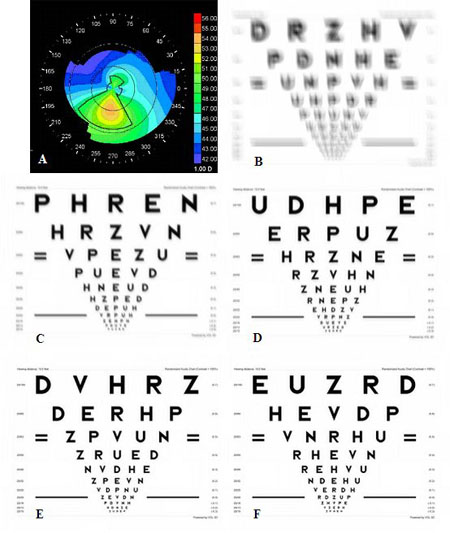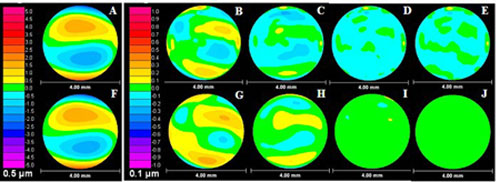Impact of Zernike-fit error on simulated high- and low-contrast acuity in keratoconus: implications for using Zernike-based corrections
This study examines the extent to which a Zernike-based optical correction can restore acuity in keratoconus as a function of disease severity and contrast level. Increasingly complete Zernike corrections in the presence of Zernike fit error were simulated.

|
Fig 2. Visual performance charts demonstrating (b) second- through (f) sixth-order Zernike corrections for the keratoconic eye with maximum corneal power of 54 D pictured in (a). Zernicke fit error is included in the simulations shown in (b) through (f). |
Acuity for keratoconic eyes with P<60D maximum corneal power reached 20/13 with a fifth-order Zernike correction under high contrast conditions and exhibited a loss of 0.1 logMAR (20/32 to 20/40) for low contrast conditions.
Acuity for keratoconic eyes with >60D maximum corneal power approached 20/13 with sixth-tenth-order corrections under high contrast conditions, but did not return to similar levels with a tenth-order correction for low contrast conditions.

|
Fig 3. Wavefront aberration, including Zernike fit error (the portion of the wavefront not characterized by the Zernike polynomial), for the (a) second- through (e) sixth-order corrections of the 54 D eye are shown. Also shown are wavefront maps for the (f) second- through (j) sixth-order corrections with fit error excluded. (a) through (e) show the wavefront errors used in the simulations for this keratoconic patient. (f) through (j) are shown to provide the reader with a feel of the distribution of the fit error shown in (a) through (e). |
The results suggest that fit error impacts visual performance for more difficult tasks and that restoring high contrast acuity (20/16 or better) using a fifth-order Zernike correction is not limited by Zernike fit error for over 85% of keratoconus cases.
OCIS codes: 330.1070 (acuity), 330.4060 (modeling of vision), 330.5370 (physiological optics)
Journal of Optical Society of America, Vol 23, No 4, April 2006; 769-776.
Received May 9, 2005; revised August 12, 2005; accepted August 31, 2005
Jason D. Marsack
Visual Optics Institute, College of Optometry, University of Houston, 505 J. Davis Armistead Bldg., Houston, TX 77204-2020, USA.
Konrad Pesudovs
NH&MRC Centre for Clinical Eye Research, Department of Ophthalmology, Flinders Medical Centre, Flinders University, Bedford Park, SA 5042, Australia.
Edwin J. Sarver
Sarver and Associates, Carbondale, IL 62902, USA.
Raymond A. Applegate
University of Houston, College of Optometry, Visual Optics Institute, 505 J. Davis Armistead Bldg., Houston, TX 77204-2020, USA.
![]()
Index of Papers
[ Welcome ][ Publications ]